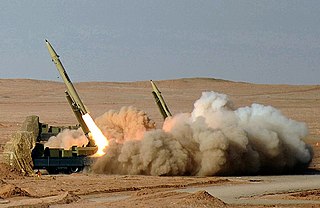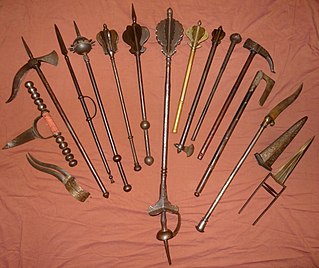 W
WThe Fateh-110, also known as NP-110 and Mushak, is an Iranian road-mobile single-stage solid-fueled surface-to-surface missile produced by Iran's Aerospace Industries Organization. The first generation of the Fateh-110 was flight tested in September 2002 and began mass production shortly thereafter. The initial range of the missile was 200 km and in September 2004 the second generation of the Fateh-110 increased the range to 250 km. The third generation of the missile, unveiled in 2010, increased the range to 300 km, and the fourth generation (2012) improved the accuracy.
 W
WThe Ghadr-110 is a medium-range ballistic missile designed and developed by Iran. The missile has a range of 1,800 km to 2,000 km. The Iranian Armed Forces first displayed the missile to the public at an annual military parade to mark the Iran–Iraq War.
 W
WShahid Haj Qasem is an Iranian ballistic missile, which was unveiled on 20 August 2020. This Iran-made missile was named after the Iranian commander Qasem Soleimani, who was assassinated by the US.
 W
WIran is not known to currently possess weapons of mass destruction (WMD) and has signed treaties repudiating the possession of WMDs including the Biological Weapons Convention, the Chemical Weapons Convention, and the Non-Proliferation Treaty (NPT). Iran has first-hand knowledge of WMD effects—over 100,000 Iranian troops and civilians were victims of chemical weapons during the 1980s Iran–Iraq War.
 W
WNasir (missile) is an Iranian naval cruise missile, which was fired during a major naval exercise called "Welayat-95" in southern waters of Iran. This cruise missile has been made by Ministry of Defence and Armed Forces Logistics (Iran). According to the (former) minister of defense, among its futures are:
 W
WThe 9A Qadr is an Iranian surface to ground precision-guided munition (PGM). It is Iran's first generation of air-launched bomb. It was developed by the missile-manufacturing companies of the Iranian Ministry of Defence, not the well-established Aerospace Industries Organisation, who build Iran surface-to-surface guided weapons.
 W
WThe saintie is an Indo-Persian parrying spear. It is a staff weapon that can be used both for offensive and defensive purposes. They have been produced since the 16th century and were used up to the 19th century. The use of saintie is extremely scarce today.
 W
WA Scud missile is one of a series of tactical ballistic missiles developed by the Soviet Union during the Cold War. It was exported widely to both Second and Third World countries. The term comes from the NATO reporting name attached to the missile by Western intelligence agencies. The Russian names for the missile are the R-11, and the R-17 Elbrus. The name Scud has been widely used to refer to these missiles and the wide variety of derivative variants developed in other countries based on the Soviet design.
 W
WSejil, or Sejjil, is a family of Iranian solid-fueled medium range ballistic missiles. The Sejil are replacements for the Shahab liquid-fueled ballistic missiles. According to US Pentagon sources, the missile profile of the Sejil closely matches those of the Ashura, Ghadr-110 and the Samen. The last test flight occurred in 2011.
 W
WThe Sevom Khordad or 3rd Khordad is an Iranian road-mobile medium range air defense missile system that was first unveiled on 11 May 2014. It is believed to be an upgraded version of the Ra'ad air defense system and somewhat superior to the other version of Ra'ad, Tabas, although it is more similar to the Ra'ad then the Tabas is. Its operational capabilities were confirmed when it shot down an American Northrop Grumman RQ-4 Global Hawk near the Strait of Hormuz. It is named after the Liberation of Khorramshahr which occurred on 3rd Khordad on the Persian Calendar.
 W
WThe Shahab-1 was the foundation of the long-range Iranian missile program. During the Iran–Iraq War, Iran purchased R-17 Elbrus missiles from Libya, Syria and North Korea (Hwasong-5). It is a close copy of Hwasong-5 (R-17).
 W
WThe Shahab-2 is the successor to the Iranian Shahab-1 missile. It is based on the North Korean Hwasong-6.
 W
WThe Shahab-3 is a quad-exhaust liquid-propelled medium-range ballistic missile (MRBM) developed by Iran and based on the North Korean Nodong-1. The Shahab-3 has a range of 1,000 kilometres (620 mi); a MRBM variant can now reach 2,000 kilometres (1,200 mi). It was tested from 1998 to 2003 and added to the military arsenal on 7 July 2003, with an official unveiling by Ayatollah Khamenei on July 20. With an accuracy of 140 m CEP, the Shahab-3 missile is primarily effective against large, soft targets. Given the Shahab-3’s payload capacity, it would likely be capable of delivering nuclear warheads. According to the IAEA, Iran in the early 2000s may have explored various fuzing, arming and firing systems to make the Shahab-3 more capable of reliably delivering a nuclear warhead.
 W
WThe Star Z-84 was a Spanish selective-fire submachine gun originally manufactured by the now defunct Star Bonifacio Echeverria, S.A.. The Z-84 is a sturdy, well-designed weapon that never saw high production due to politics. Originally manufactured for use by SCUBA divers, the Z-84 could be used right out of the water without any need to drain the working parts or magazine, known as over-the-beach or OTB capability.
 W
WZelzal-3 is an Iranian-made solid propellant unguided artillery rocket with a range of 200 km. It is an upgrade of the Zelzal-2 rocket with slightly improved range and was first shown to the public in 2007. A variant, the Zelzal-3B, has a smaller warhead and a range of 250 km. The shape and dimensions of the Zelzal-3 are nearly identical with previous versions except that the nosecone is cone shaped rather than the dome shaped Zelzal-2 and Zelzal-1. The Zelzal-3 has revived little use as the much more accurate Fateh-110 missile was also developed from the Zelzal-2.
 W
WThe Zolfaghar missile is an Iranian road-mobile, single-stage, solid-propelled SRBM named after the sword of Ali ibn Abi Talib Zolfaghar. It is believed to be derived from the Fateh-110 SRBM family. It was first unveiled in 2016 and entered service in 2017 as a longer range version of the Fateh-110 SRBM. It was first used in the 2017 Deir ez-Zor missile strike and was therefore one of the first used mid-range missiles since 30 years.